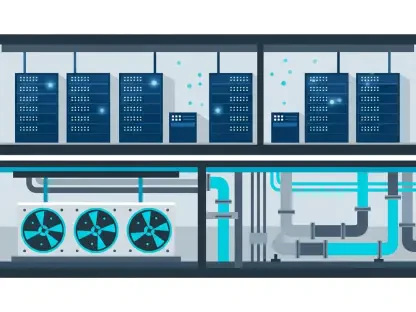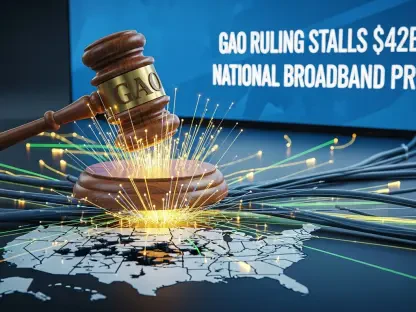Unpacking the Telecom Sector’s Complex Dynamics
Imagine a nation of 1.2 billion telecom subscribers, where data consumption skyrockets to over 228,000 petabytes annually, yet millions in rural areas still struggle to get a stable connection, defining India’s telecom landscape in 2025. This stark contrast highlights a market teeming with potential but riddled with disparities. The latest data from the Telecom Regulatory Authority of India (TRAI) for the period of April 2024 to March 2025 offers a critical window into these trends, revealing both the impressive strides in technology adoption and the persistent challenges of equitable access. This analysis aims to dissect these patterns, providing stakeholders with actionable insights into a sector at a pivotal juncture.
Understanding the telecom market’s trajectory is paramount for operators, policymakers, and investors navigating an industry that underpins India’s digital economy. With 5G adoption accelerating and data usage soaring, the opportunities for innovation are immense, yet the urban-rural divide threatens to widen if left unaddressed. This examination will delve into subscriber trends, revenue shifts, and connectivity gaps, while projecting future directions based on current indicators. The goal is to equip decision-makers with a clear perspective on where the market stands and what strategic moves can drive inclusive growth.
Market Trends and In-Depth Analysis
Subscriber Patterns: A Plateau with Persistent Gaps
The Indian telecom market has hit a saturation point in subscriber growth, with the total base reaching 1.2 billion by March 2025, reflecting a negligible year-over-year increase of just 0.13%. This stagnation is mirrored by a slight dip in overall teledensity, sliding from 85.69% to 85.04%, signaling that the market has little room for expansion in terms of new users. The urban-rural disparity remains a critical fault line, with rural teledensity at a mere 59.06% compared to a staggering 131.45% in urban areas, highlighting inadequate infrastructure and affordability barriers in less populated regions.
Breaking down the categories, wireline services emerged as a bright spot, growing by 9.62% to 37.04 million subscribers, with 90% concentrated in urban centers. This uptick points to a rising demand for reliable high-speed internet, likely fueled by remote working trends and digital content consumption in cities. In contrast, wireless subscriptions saw a marginal decline of 0.15%, totaling 1.16 billion, with mobile-only users dropping by 0.73%, a shift attributed to consumers consolidating SIMs in response to recent tariff hikes. This trend suggests a market where urban saturation contrasts sharply with rural under-penetration, posing a dual challenge of retention and expansion.
Looking at regional dynamics, the data indicates that while metro areas are overserved, rural markets hold untapped potential that operators have yet to fully capitalize on. The sluggish growth in subscriber numbers could push companies to focus on enhancing service quality over quantity, especially in underserved areas. However, without targeted investments in rural network coverage, the digital divide risks becoming a permanent feature of the telecom landscape, limiting the sector’s overall growth potential.
Revenue Shifts: Prepaid Gains Offset Postpaid Pressures
On the financial front, the telecom sector presents a mixed outlook with notable gains in certain segments. The average revenue per user (ARPU) for wireless services surged by 16.89%, rising from INR 149.25 (US$1.73) to INR 174.46 (US$2.03), driven primarily by tariff increases in the prepaid category, where ARPU climbed from INR 146.37 (US$1.7) to INR 173.84 (US$2.02). This upswing reflects operators’ strategies to bolster revenue amid stagnant subscriber numbers, focusing on extracting more value from existing users.
However, the postpaid segment tells a different story, with ARPU declining from INR 184.63 (US$2.14) to INR 180.86 (US$2.10), possibly due to competitive pricing pressures or a consumer shift toward more flexible prepaid plans. This divergence suggests that while prepaid users are bearing the brunt of tariff adjustments, postpaid subscribers may be seeking cost-effective alternatives. Meanwhile, average minutes of usage per subscriber per month rose by 3.9%, from 963 to 1,000 minutes, indicating that voice services remain a steady engagement driver despite the data-centric focus.
The revenue trends underscore a strategic pivot toward maximizing income from current subscribers rather than expanding the base. Yet, this approach carries risks, particularly in price-sensitive rural markets where higher tariffs could deter adoption. Operators might need to balance revenue goals with affordability initiatives to maintain a broad customer base, especially as competition intensifies in urban hubs where postpaid declines are evident.
Data Boom and Connectivity Challenges: A Dual Reality
The explosion in data consumption stands out as a defining feature of the telecom market, with average usage per subscriber reaching 21.53 GB per month and total mobile data usage climbing 17.46% to 228,779 petabytes. The breakdown shows 4G dominating at 170,603 petabytes, while 5G usage leaped from 21,074 to 57,042 petabytes, marking rapid adoption of next-generation technology in areas with coverage. This surge highlights the transformative potential of advanced networks to support emerging applications in sectors like education and telemedicine.
Despite this progress, internet penetration reveals stark inequities, with subscribers growing modestly by 1.54% to 969.10 million, including 944.12 million broadband users. The rural internet density of 45.03% lags far behind the urban figure of 110.79%, reflecting systemic issues in infrastructure rollout and digital literacy. This connectivity gap limits the benefits of data growth to urban centers, leaving rural communities disconnected from the digital economy’s advantages.
Projections suggest that while 5G will continue to drive data consumption, its impact will remain uneven without parallel efforts to enhance rural access. The market could see a widening divide if investments do not prioritize underserved regions. Addressing this requires innovative models, such as shared infrastructure or government-backed subsidies, to ensure that the data boom translates into inclusive growth rather than concentrated gains.
Future Projections: Navigating Innovation and Inclusion
Looking ahead, the telecom sector is poised for a transformative phase with 5G as a key catalyst. The rapid increase in 5G data usage signals a shift toward next-generation applications, from smart cities to industrial automation, particularly in urban markets. Wireline growth also hints at a resurgence of fixed broadband as a reliable connectivity option, potentially supporting hybrid work and entertainment needs over the next few years.
Regulatory and economic factors will shape the market’s trajectory, with spectrum auctions and policies on data pricing likely to influence operator strategies. Economic challenges, such as rural income constraints, may slow expansion in untapped areas unless offset by targeted incentives. Analysts anticipate a stronger focus on data-centric revenue models, possibly leveraging artificial intelligence for network optimization and personalized offerings from 2025 to 2027.
The uncertainty lies in balancing technological advancement with equitable access. If current trends persist, urban markets will continue to lead innovation, while rural regions risk falling further behind. The industry might witness increased public-private collaboration to address infrastructure gaps, with government initiatives potentially playing a larger role in ensuring digital inclusion remains a priority over the coming years.
Reflecting on Insights and Charting Strategic Paths
Looking back, the analysis of India’s telecom market revealed a landscape of contrasts, where subscriber growth stagnated at 1.2 billion while data usage soared to unprecedented levels. The robust 16.89% rise in prepaid ARPU and the dramatic increase in 5G consumption underscored a shift toward data-driven profitability and technological advancement. Yet, the persistent urban-rural divide, evident in teledensity and internet penetration disparities, highlighted deep-rooted inequities that constrained the sector’s broader impact.
For stakeholders, the path forward demands a strategic focus on rural expansion through affordable pricing and infrastructure investments. Operators need to explore partnerships with local authorities to boost digital literacy and drive adoption in underserved areas. Policymakers must consider incentives for rural connectivity and streamlined regulations to accelerate 5G rollout. By aligning efforts to bridge connectivity gaps and harness emerging technologies, the industry can transform challenges into sustainable growth opportunities, ensuring that digital access becomes a universal reality rather than an urban privilege.









